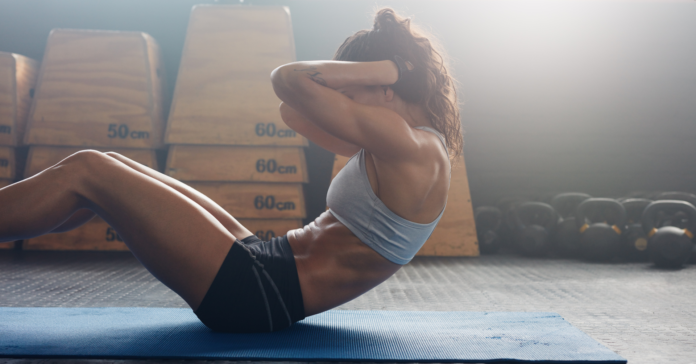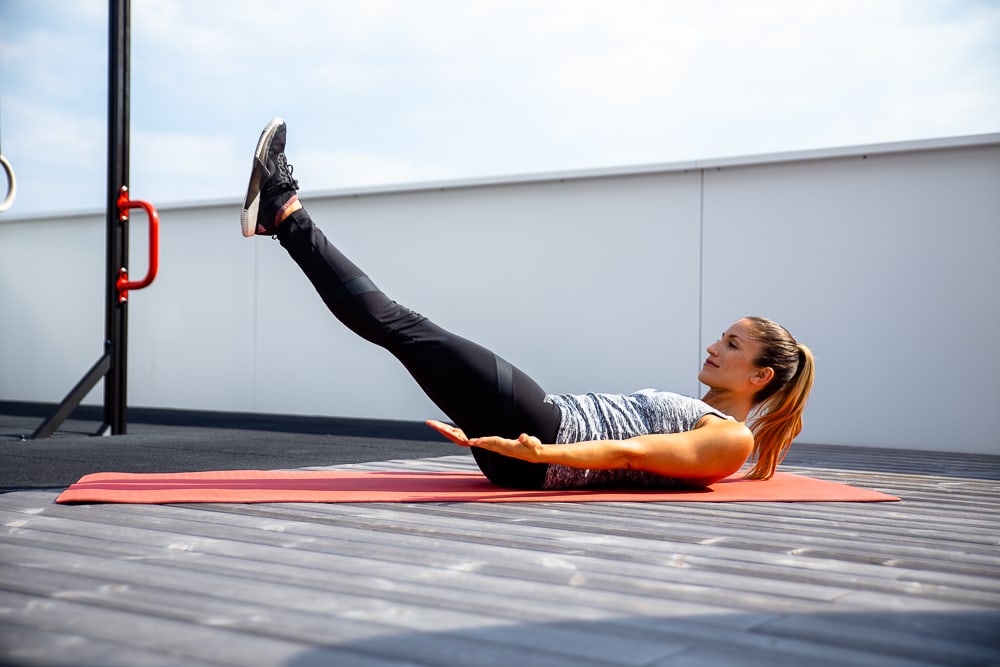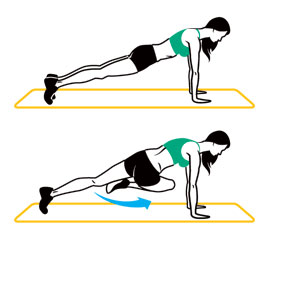Your next ab workout should include these 20 core exercises to strengthen and tone your abs. Exercises that strengthen your core will help you remain healthy and pain-free. The same workout will sculpt your abs and strengthen your core!
Your core is your center of gravity. In everyday life and during exercise, a strong core allows for better functional movement. No matter what you’re doing, whether you’re exercising, cooking, or sitting down at work, you should engage your core constantly. A strong core will help prevent injury and promote more efficient workouts overall.
5 REASONS WHY YOU NEED TO BE DOING CORE EXERCISES
1) Exercises Strengthen Core Muscles
It may seem like a no-brainer, but doing core exercises builds core strength. The key to strengthening a muscle group is to do exercises to strengthen it!
2) Improve Posture
Why is having a strong core important? Good posture is a result of a strong, healthy core. A healthy body, particularly a healthy back, results from good posture. Poor posture is caused by slumping in chairs and arching the neck while looking at screens; a strong core can help counteract this inclination.
3) May Improve Running/Training Performance And Balance
Exercises for the core do more than only develop six-pack abs! Exercises for the core are excellent for enhancing general balance. A strong foundation is necessary for running and training. A solid core contributes to creating and maintaining that foundation. Since almost every movement involves the core, strengthening it makes sense!
4) Core Exercises Help Reduce Injury When Combined With Full-Body Strength Training
Not only does having a strong core benefit your running and other exercises, but it can also lower your chance of injury. As a result, athletes perform better because they have more time and energy to exercise safely with fewer injuries. A wonderful technique to armor the body is via a total-body strength training program.
5) Reduce Lower Back Pain And Stiffness
The majority of people experience lower back stiffness and pain. Strengthening your core can help you feel better. As was already said, it also lowers the chance of suffering another injury.
WHICH MUSCLES CORE EXERCISES WORK
Most individuals picture their abs when they think of their core muscles. However, there are more than 12 distinct muscles that make up the core! They consist of both the outer and deep core muscles. When completing core workouts, you should anticipate working the following muscles:
1) Deep Core Muscles
- Pelvic floor muscles (supports vital organs)
- Transverse abdominis (the muscles that help protect the spine)
- Internal obliques (muscles on the sides of the abdomen)
- Multifidus (deep back muscles)
- Diaphragm (primary respiration muscle)
2) Outer Core Muscles
- Rectus abdominis (six-pack abs muscles)
- External obliques (muscles on sides of the abdomen)
- Erector spinae (lower back muscles)
- Quadratus lumborum (part of the abdominal wall)
- Hip muscles including glutes, hamstrings and quads
THE 20 BEST CORE EXERCISES
1) HOLLOWMAN
As an isometric hold, this exercise causes the core muscles to contract while the body remains still. This is a terrific exercise to strengthen your core from the ground up. Given that it is a static hold, it is also excellent for anyone whose lower back hurts when they move.
Here’s how: Legs should be at a 45-degree angle, arms by your side, and chin tucked. Your back ought to be parallel to the ground. Squeeze your glutes, quads, and stomach while pulling your hip bones and rib cage together. To activate the diaphragm, take a deep breath. Your chin should be tucked. Pull your shoulders away from your ears and downward.
Both new and experienced athletes will benefit greatly from this core exercise. The exercise can be modified to suit different levels of athletes:
- Beginners: Bend knees, tuck chin
- Intermediate: Legs straight, chin slightly tucked, arms by sides and palms face up
- Advanced: Raise your hands above your head and/or lower legs closer to the ground
SETS & REPS
- 40 seconds hold
- 20 seconds rest
- Perform 3-4 sets
COMMON ERRORS
- Not breathing
- being separated from the floor by the back. As a result, you are straining your lower back because your core is not actively engaged.
- Before mastering the simpler option, try the more difficult one. Start with the bare minimum advised and progress to more repetitions, sets, and challenging variations.
2) High Plank
Muscles Involved
- Core muscles (Transverse abdominis, rectus abdominis, internal/external obliques)
- Anterior Deltoids (Shoulders)
- Pectoralis Muscles (Chest)
- Glutes, quads, hamstrings, calves
Here’s how: Lay your hands and legs shoulder-width apart on the ground. Maintain a neutral neck while glancing forward yet still downward. To use your core muscles and prevent lower back pain, keep your butt tucked in, your back flat, and your stomach firm. Since your legs and glutes are an extension of your core, make sure to squeeze them. It can feel good to round your shoulders, and it supports the lower back.
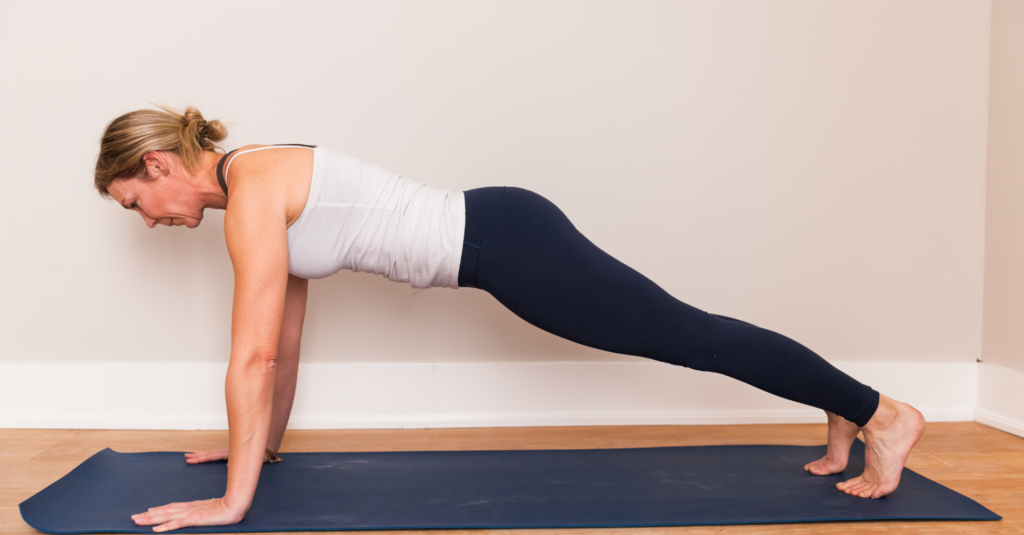
This exercise is appropriate for intermediate athletes, however, the following modifications can make it simpler:
- Drop your knees to make it simpler.
- Make it more difficult by placing your hands on an unstable surface, such as a basketball.
SETS & REPS
- Hold for 40-60 seconds
- 20 second rest
- 3 sets
COMMON EXERCISE MISTAKES
- Sticking your butt out
- Not activating your leg muscles
- Looking up
3) Glute Bridge
MUSCLES WORKED
- Glutes
- Hamstrings
- Erector spinae
- Transverse abdominis (Keeping stomach tight
Here’s how: Lie flat on your back with your feet shoulder-width apart. Hold your hands firmly to the ground. Slowly raise your hips by contracting your glutes (butt) and keeping your midsection (core) tight.
Go back to your starting point.
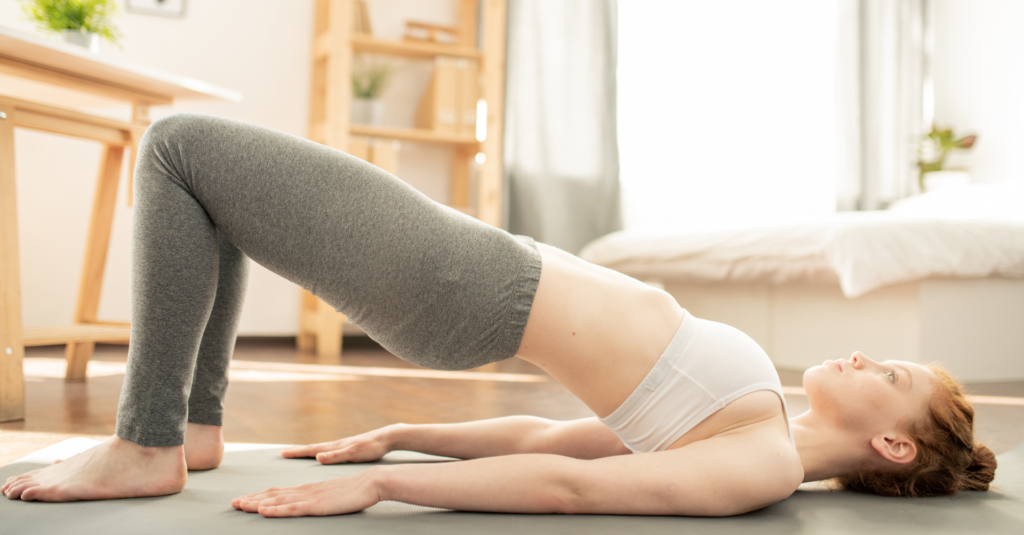
Be reminded to keep your chins tucked and also keep hip bones and rib cage tucked together and core engaged.
Beginners can safely perform this workout. The difficulty can be raised to provide more strength stimulus. At the top of the bridge, extend one leg out to make the exercise more difficult. Change legs. Both legs extended equals one set.
SETS & REPS
- 20 reps
- Rest for 20 seconds between sets
- Work up to 3 sets
COMMON EXERCISE MISTAKES
- Performing too quickly
- Not engaging core muscles
- Not squeezing glutes at the top
- Losing form at the top
4) Superman Pull
MUSCLES WORKED
- Erector spinae
- Glutes
- Hamstrings
- Latissimus dorsi (known as “lats)
- Shoulders
- Core muscles
Here’s how: Lay on your stomach, arms raised, and legs straight. Engage your back and glute muscles as you lift your arms and legs off the ground. To engage your back and shoulder muscles, bend your elbows in a “W” shape and pull them back and downward. Reverse the order to return to the starting position.
Maintain a firm chin tuck throughout the movement, stabilizing your neck while engaging your core muscles. Squeeze your back, shoulders, glutes, and hamstrings. Lastly, do not rush the movement.
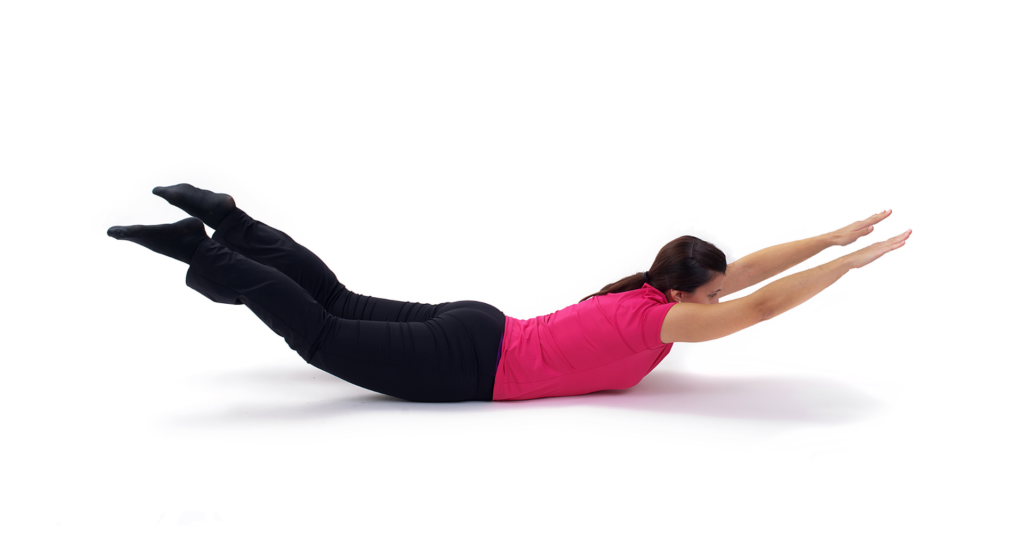
This exercise is suitable for intermediate-level athletes.
SETS & REPS
- 20 reps
- Rest for 20 seconds between sets
- Work up to 3 sets
COMMON EXERCISE MISTAKES
- Performed too fast
- Not focusing on squeezing all relevant muscles
- Ignoring core muscles
5) V-UPS
MUSCLES WORKED
- Rectus abdominis
- Transverse abdominis
- Internal and external obliques
- Hip flexors
Here’s how: With your arms raised above your head, lie on your back. Feet should be together or as close together as possible while keeping your legs straight. Lift your knees off the ground and roll your shoulders off the floor to “crunch” your tummy. Try to maintain a generally straight line. Where your hands and legs meet, create a “V” shape with your body. Slowly revert to the beginning position.
Remember, throughout the exercise, keep your core tight. Maintain a tucked-in chin and nearly straight legs. On the way up, exhale, and on the way down, inhale.
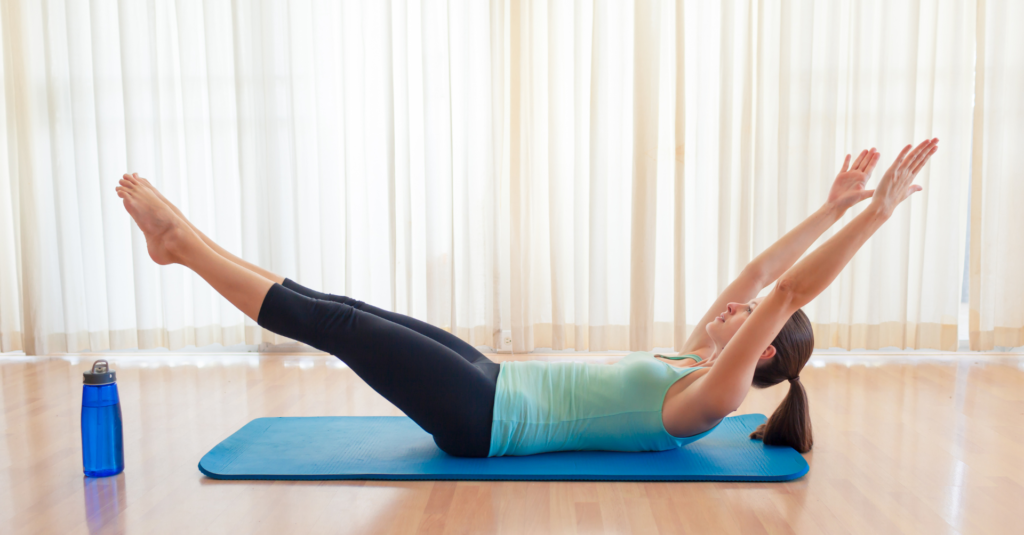
This exercise is for advanced athletes. Beginner and intermediate athletes should try normal crunches instead.
SETS & REPS
- Perform 15-20 reps
- Rest for 20 seconds between sets
- Work up to 3 sets
COMMON EXERCISE MISTAKES
- Performing too fast
- Holding your breath
- Not engaging your core
- Not keeping chin tucked
- Bending your legs and performing a standard crunch
6) V-UP HOLD ARM PUMP
MUSCLES WORKED
- Transverse abdominis
- Rectus abdominis
- Obliques
- Quads
- Hip flexors
Sit on your butt. Lean your torso back and raise your legs 45 degrees off the ground (or as close as you can get) and maintain straight legs and keep your feet together. Engage your core muscles. Make sure your back is not arched. Keep your arms straight while slowly raising and lowering them.
Throughout the movement, maintain a firm core and tuck your chin in. Pull your shoulders away from your ears and downward (no shrugging). To prevent your back from rounded incorrectly, “curl” your hip bones up to your rib cage.
Athletes in the intermediate range can perform this workout. Beginner athletes should aim to gradually increase their ability to perform this workout. This exercise can be used as core maintenance work by advanced athletes.
SETS & REPS
- Hold for 30-40 seconds
- Rest for 20 seconds between reps
- Work up to 3 sets
COMMON EXERCISE MISTAKES
- Swing arms too fast
- Lose core engagement
- Not tucking your chin in
- Not breathing
7) Cross Body Planks
MUSCLES WORKED
- Core muscles (Transverse abdominis, rectus abdominis, internal/external obliques)
- Anterior Deltoids (Shoulders)
Cross Body Planks are a core workout that tone all the muscles in your arms, shoulders, lower back, and abdomen. The cross-under action of the knee toward the opposing elbow is what makes the Cross Body Plank special. This activates the oblique muscles that define your waist and bolster your stability and core strength. Any sort of plank is excellent for strengthening your core, but learning how to execute cross body planks gives you a motion that effectively works almost all of the muscles in your core. To see results, you won’t need to complete many of these!
Here’s How: Start in a plank posture with your feet together, your shoulders over your wrists, and your body in a straight line. When your left elbow touches your right knee, release and return to the starting position. Next, tuck your left leg under until it touches your right elbow, then exhale to return to the starting position. Repeat for the appropriate amount of reps. Maintain a tight core and a controlled body.
SETS & REPS
- Perform 15-20 reps
- Rest for 20 seconds between sets
- Work up to 3 sets


